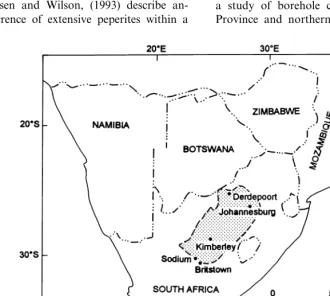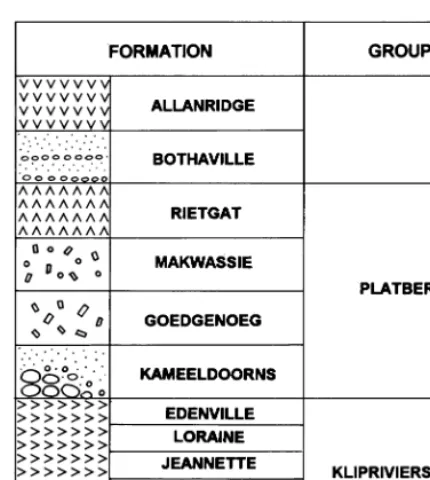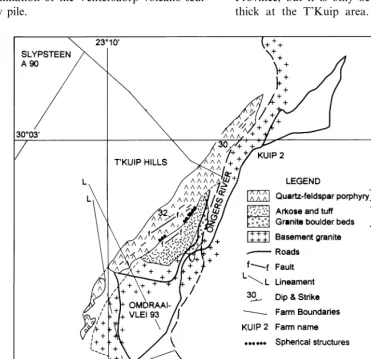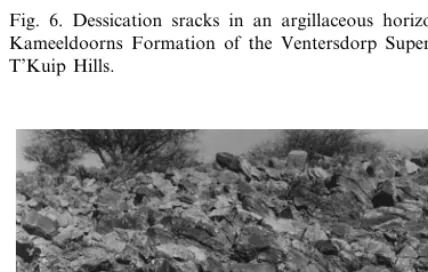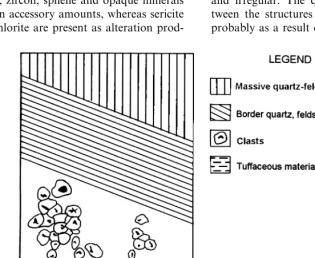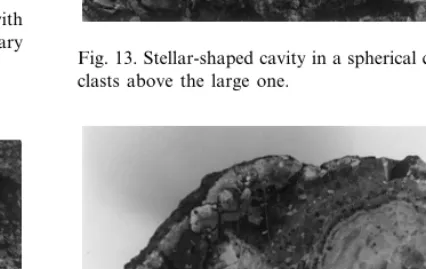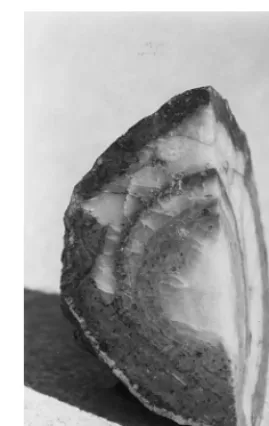High temperature ash flow – wet sediment interaction in the
Makwassie Formation, Ventersdorp Supergroup,
South Africa
W.A. van der Westhuizen *, H. de Bruiyn
Department of Geology,Uni6ersity of the Orange Free State,P.O.Box339,Bloemfontein,9300,South Africa
Abstract
The Late Archaean Ventersdorp Supergroup in South Africa constitutes a supracrustal succession consisting of mafic lava at the base that is overlain by a clastic wedge deposit, known as the Kameeldoorns Formation, which formed in grabens that were the result of extensional tectonics. Overlying these units is an intermediate to felsic ash-flow deposit, the Goedgenoeg and Makwassie Formations, that are now represented by feldspar and quartz-feldspar porphyries. At T’Kuip in the Northern Cape Province, spherical structures or clasts varying greatly in size occur at the contact of the Makwassie Formation with the underlying sedimentary Kameeldoorns Formation. The larger clasts have cavities of different shapes and are regarded to have developed as a result of the deposition of a high temperature ash-flow onto water saturated sediments. © 2000 Elsevier Science B.V. All rights reserved.
Keywords:Ash flow; Wet sediment; Makwassie Formation; Ventersdorp Supergroup
www.elsevier.com/locate/precamres
1. Introduction
The Ventersdorp Supergroup represents a late Archaean (early Proterozoic; :2.7 Ga; Arm-strong et al., 1986) supracrustal succession on the Kaapvaal Craton (Grobler et al., 1989; Van der Westhuizen et al., 1991). This succession is the second in a series of four basins that developed between 3.2 and 2.1 Ga on the Kaapvaal Craton representing the largest and most widespread se-quence of volcanic rocks on the craton. It
occu-pies an elliptical area of :300 000 km2 (Pretorius, 1976) that extends for about 750 km along a north-east axis from Sodium in the Brit-stown District of the Northern Cape Province to Derdepoort in the Northwestern Province with a width of 350 km at its widest. It consists of a 5100 m thick sequence of sub-aerial volcanic rocks as well as intercalated sedimentary units that attains a thickness of up to 2900 m (Van der Westhuizen et al., 1991). Current research by Winter and Van der Westhuizen suggests that the Ventersdorp basin was much greater than the present outline delineated in Fig. 1. The best exposures are found in the Northwestern Province, Northern Cape Province, Gauteng and southern Botswana. * Corresponding author. Tel.:+27-51-4012515; fax:+
27-51-4478501.
E-mail address: [email protected] (W.A. van der Westhuizen)
Interesting enigmatic structures were found at the base of the quartz-feldspar porphyry of the Makwassie Formation in the Britstown District at T’Kuip. They are similar to structures that result from the interaction of lava with wet sediments and from subaqueous lava flows. Many of these features are elsewhere described as peperites, but by definition a peperite is the result of the interac-tion of a lava flow with wet sediment. Numerous examples of basalt to andesite peperites have been described (Schmincke, 1967; Kokelaar, 1982; Walker and Francis, 1987; White and Busby-Spera, 1987; Kano, 1989). According to Hansen and Wilson (1993) descriptions of rhyolite peper-ites are rare and restricted to intrusive margins. They mention one example of large-scale interac-tion between silicic magma and wet sediment to form voluminous peperites (Snyder and Fraser, 1963). Hansen and Wilson, (1993) describe an-other occurrence of extensive peperites within a
Jurassic volcano-tectonic rift basin in southern Chile. The structures in the Makwassie Formation at T’Kuip resemble peperites to a certain extent, but as will be seen from the detailed description, have characteristics that have not been reported in peperites. The purpose of this paper is to describe these rare and unique features and to present a case for their possible origin.
2. General geology and stratigraphy of the Ventersdorp Supergroup
The stratigraphy of the Ventersdorp Super-group (Fig. 2) consists of the basal Klipriviersberg Group (mafic lavas), which Winter and De la (1976) subdivided into six formations on the basis of lithological criteria as revealed by results from a study of borehole cores from the Northwest Province and northern Free State. The
Fig. 2. Stratigraphic profile of the Ventersdorp Supergroup.
This silicic formation has the extent and geome-try of an ignimbrite, while in some instances characteristics of lava flows are apparent. Contro-versy exists over the origin of voluminous silicic rocks including the Bruneau – Jarbidge area of Idaho (Ekren et al., 1984), Baja California (Haus-back, 1987), Australia (Cas, 1978) and southern Africa (Cleverly and Bristow, 1982). Henry et al. (1988) described widespread, lava-like silicic vol-canic rocks of Trans-Pecos Texas. They evaluated two end-member hypotheses: (1) that these rocks originated as either ignimbrites in which extreme rheomorphism has obliterated primary internal features or (2) that they are highly viscous lavas with unusually high heat retention or effusion rates that allowed them to spread over great areas. Green and Fitz (1993) also describe exten-sive felsic lavas and rheoignimbrites in the Ke-weenawan Midcontinent Rift plateau volcanics, Minnesota.
In the study area evidence such as lithic frag-ments and the recognition of flow features indi-cate an ignimbrite-type origin at T’Kuip. Meintjes (1998) also recognized flow units in the Mak-wassie Formation that consist of a lowermost dark-coloured, silicified basal layer followed by a phenocryst-rich base, often epidotized, with large (up to 7.5 mm) crystals and mafic inclusions. This is in turn followed by a phenocryst-rich middle layer with chloritic laminae, colour banding and false clastic textures. The upper part consists of an amygdaloidal upper layer with smaller fragmented phenocrysts and elongated amygdales towards the top. Uppermost is a brecciated, weathered top (Meintjes, 1998).
Quartz-feldspar porphyry from the lower part of the phenocryst-rich layer represents material of higher density than the expanded matrix of a moving pyroclastic flow. This higher density ma-terial would settle at the flow base through gravi-tation (Cas and Wright, 1987), thus accounting for the concentration of larger size phenocrysts in the lower part of the middle layer. Preferential concentration of phenocrysts was also observed in ash-flows of the Sleeping Lion Formation in the Davis Mountains, USA by Franklin et al. (1987) and Henry et al. (1989).
iersberg Group represents a flood basalt sequence varying between 1500 and 2000 m in thickness. Myers et al. (1990) deduced that the volcanism started in the east with the eruption of komatiitic lavas, became less voluminous, before resurging with the depocentre shifting to the west and be-coming progressively more magnesium-rich.
The upper part of the Platberg Group is repre-sented by the Rietgat Formation. This is a succes-sion consisting of mafic volcanic rock, tuffs as well as tuffaceous siltstone and stromatolitic cherty limestone that developed during the subsi-dence stage after the volcanic emanations (Grob-ler et al., 1989).
The upper part of the Ventersdorp Supergroup is made up of the Bothaville Formation; a sedi-mentary unit comprised of conglomerates and quartzites. Another mafic to intermediate volcanic succession, the Allanridge Formation, overlies the sedimentary Bothaville Formation and represents the culmination of the Ventersdorp volcano-sedi-mentary pile.
3. The geology of the T’Kuip Hills
The geology of the basal part of the Venters-dorp Supergroup at T’Kuip Hills between Brit-stown and Prieska in the Northern Cape Province is depicted in Fig. 3 and a profile is presented in Fig. 4.
The Platberg Group is generally absent from the northeastern region of the depository and outcrops inconsistently over the rest of the area, where large variations in thickness occur. The thickness of the Makwassie Formation can reach up to more than 1000 m in the Northwest Province, but it is only between 200 and 300 m thick at the T’Kuip area. Here the Makwassie
Fig. 4. Simplified stratigraphic profile of the Ventersdorp succession in the study area (modified after Grobler et al., 1989).
Formation directly overlies Kameeldoorns For-mation. Numerous layers of tuffaceous material occur in the latter unit. The tuffaceous material is intercalated with argillaceous material derived from the granitic basement that forms the base-ment to the Ventersdorp Supergroup rocks in the study area.
Deposition of the lower Ventersdorp Super-group took place in a half-graben at this locality (Grobler et al., 1989). The basal member of the Kameeldoorns Formation, previously described
Fig. 5. Raindrop imprints on argillaceous horizon in the Kameeldoorns Formation of the Ventersdorp Supergroup at T’Kuip Hills.
Fig. 8. Agglutinated unit at the base of the Makwassie Forma-tion below (Fig. 7).
this locality in contrast to other Kameeldoorns exposures. Laterally, towards the northeast of the main outcrop, tuffaceous material becomes domi-nant and raindrop imprints as well as desiccation cracks occur (Van der Westhuizen et al., 1991). Close to the contact with the Makwassie, sheared material resembling shales and/or tuffaceous ma-terial was observed. Very little disturbance of the underlying material was observed, but the lack of outcrop immediately above the contact between the sediment and the quartz-feldspar porphyry hampers a more detailed investigation.
The occurrence of raindrop imprints and desic-cation cracks suggest shallow water deposition and periodical exposure, the argillaceous material was probably deposited during floods, as sup-ported by the presence of upward-fining cycles and graded bedding.
The basal unit of the Makwassie Formation varies from 1 to 2 m in thickness and consists of quartz-feldspar porphyry clasts of different sizes distributed in a matrix of altered rhyolitic mate-rial (Fig. 7).
Another primary feature of the basal Mak-wassie unit is depicted in Fig. 8 and consists of what resembles agglutinated material. Accretion-ary lapilli were also observed along strike in the basal unit. This forms the base of the unit and is overlain by the thinly banded tuff of between 1 and 1.5 m thick as depicted in Fig. 7.
The banding is mesoscopically visible as alter-nating lenses of lighter and darker material, the Fig. 6. Dessication sracks in an argillaceous horizon in the
Kameeldoorns Formation of the Ventersdorp Supergroup at T’Kuip Hills.
latter possibly being fiamme that are strongly flattened. The thickness of these lenses is between 1 and 10 mm. Both the light and dark bands have visible phenocrysts of quartz and feldspar, al-though the percentage of phenocrysts is lower in the darker ones than the lighter ones.
Also present are occasional lithic fragments of mainly basement granite and irregular, though elongated isotropic bodies that may represent remnant fiamme in the rhyolitic tuff. Similar fea-tures in rocks from the Ritchie area, which are presently stratigraphically correlated with the Makwassie Formation, were described as fiamme in eutaxitic ignimbrites (Potgieter and Lock, 1978). The bulk of the Makwassie Formation, however, consists of a unit of massive quartz-feldspar porphyry, with phenocrysts of quartz, feldspar and cryptocrystalline material. The latter is probably a devitrification product of volcanic glass, visible as distinct patches of differing grain size. Apatite, zircon, sphene and opaque minerals are present in accessory amounts, whereas sericite flakes and chlorite are present as alteration
prod-ucts. The feldspar phenocrysts in the clasts of the basal unit show a high degree of alteration, whereas higher up in the Makwassie succession, they are in a better state of preservation. The contact between the basal unit with the clasts and the banded unit is sharp, whilst the latter unit grades into the upper massive rhyolite (Fig. 9).
4. Structures in the basal unit
The round structures in the basal unit (Fig. 7) vary in size from a few millimeters up to close to 500 mm. Most of the larger structures have cavi-ties of different shapes and sizes in the centre, similar to the lithophysae described for the Blue Creek tuff, Snake River (Plate 3.7, McPhie et al., 1993). Some have cavities of a septarium nature (Grobler et al., 1989), whilst others have cavities comparable to a bow-tie shape, stellar, triangular and irregular. The quartz-feldspar porphyry be-tween the structures is invariably highly altered, probably as a result of the interaction with steam
Fig. 10. Different size clasts-note the cavities in the larger ones. Scale object is 15 mm long.
from the underlying sediments during deposition (Figs. 10 and 11). The material between the clasts seems to be non-welded, but its altered nature precludes a definite conclusion. Some examples of these structures are presented in Figs. 10 – 13.
Interesting features were observed in two struc-tures that were cut in half (Figs. 14 and 15). In both instances the samples have an outer shell of quartz-feldspar porphyry, 15 (Fig. 14) and 10 mm thick (Fig. 15), respectively. Inward this is fol-lowed by a quartz sphere with a maximum thick-ness of 20 mm in Fig. 15 and 3 mm in Fig. 14. Alternating concentric spheres of quartz-feldspar porphyry and quartz inwardly follows this zone of quartz. The quartz infilling probably took place by hydrothermal action soon after emplacement.
Fig. 11. Similar to Fig. 10 but in this case on the contact with underlying sediment. No major disruption of the sedimentary
material occurs at this locality. Fig. 13. Stellar-shaped cavity in a spherical clast. Note smaller clasts above the large one.
Fig. 14. Example of concentric quartz-feldspar shells with quartz between the shells and a quartz-filled cavity in the centre. Sample is 150 mm long.
Fig. 15. Another example similar to Fig. 14 but with a thick outer cavity filled by quartz. Sample is 100 mm from left to right.
and crowded with large siliceous nodules up to 400 mm in diameter. Smaller nodules of up to 50 mm are also mentioned.
Wright and Coward (1977) regarded the pres-ence of such nodules as a good indication of deposition of an ash-flow into water or onto water saturated sediments. Reedman et al. (1987) described a similar setting for the Pitts Head Tuff Formation to that of the Makwassie Formation at T’Kuip where the tuff was deposited upon alluvial fans and fan fringe sediments. They as-cribe the growth of the siliceous nodules to the entrapment of volatiles near the base of the zone of most intense welding.
Different possible scenarios can thus be envis-aged for the development of these structures at T’Kuip. The flattened base of some of these fea-tures may be indicative of a very high temperature or alternatively secondary heat produced by the overlying pile of hot ash in the process of being welded. This scenario is, however, regarded as unlikely as the sediments underneath would have exerted a cooling effect near the base of the unit. Another possibility is fast cooling in a gas-rich environment, whilst another can be a process of accretion in a high temperature ash-flow in the presence of water vapour. In an experiment where granitic material was melted with a flux and quenched in water, a structure similar to those described in the basal unit was produced. The structures in the basal unit were only observed at this one locality and even though many bore hole cores penetrate the Makwassie/Goedgenoeg con-tact with the Kameeldoorns Formation, nothing similar was detected.
Wright and Coward (1977) have suggested that the nodules in the Pitts Head Tuff Formation may represent original gas cavities, lithophysae, which were later filled in by silica. At the T’Kuip occurrence, the spheres definitely do not represent gas cavities as they consist of quartz-feldspar por-phyry. Rapid cooling may have produced volcanic glass that devitrified and produced these struc-tures, or they may be the result of contraction as a result of cooling in the presence of volatiles such as steam. Structures such as those in Fig. 11 seem to be primary and will probably not conform to An indication for the cessation of hydrothermal
activity is evidenced by the presence of both filled and unfilled cavities. In the sample depicted in Fig. 15, it is evident that the spheres all rest or converge on what probably represented the base or floor of the structure. The spheres have a flattened appearance in this area, while they also appear similar to the shells produced by exfoliation.
5. Discussion
devitrification. The formation of these structures are probably the result of a combination of fac-tors such as a rapid cooling rate in the presence of volatiles combined with a source of heat from the overlying hot ash-flow. During this process of heating, silica proceeded to fill some of the cavi-ties in the centres of the clasts.
6. Conclusions
A unit at the base of the Makwassie Formation at T’Kuip in the Northern Cape Province con-tains spherical structures (clasts) which is overlain by a banded sequence of quartz-feldspar porphyry with a thickness of between 1 and 2 m. The quartz-feldspar porphyry upwards becomes mas-sive and attains a thickness of more than 200 m. The spherical structures are interpreted to have resulted from the deposition of high-temperature ash-flow material onto water saturated sediments.
Acknowledgements
The authors would like to acknowledge the financial support of Billiton SA, the Foundation for Research Development and the University of the Orange Free State. The University is also thanked for the use of facilities.
References
Armstrong, R.A., Compston, W., Retief, E.A., Welke, H.J., 1986. Ages and isotopic evolution of the Ventersdorp volcanics. Abstr. Geocongress ’86, Geol. Soc. S. Afr., 89 – 92.
Cas, R.A.F., 1978. Silicic lavas in Paleozoic flyschlike deposits in New South Wales, Australia: behavior of deep sub-aqueous silicic flows. Geol. Soc. Am. Bull. 89, 1708 – 1714. Cas, R.A.F., Wright, J.V., 1988. Volcanic Successions:
Mod-ern and Ancient. Unwin Hyman, London, p. 526. Cleverly, R.W., Bristow, J.W., 1982. Flow-banded and
con-torted tuffs: examples from southern Africa (Lebombo Province) and western North America. Geological Society of America Abstracts with Programs 14, 464.
Ekren, E.B., McIntyre, D.H., Bennett, E.H., 1984. High-tem-perature, large-volume, lavalike ash-flow tuffs without calderas in southwestern Idaho. U.S. Geol. Surv. Prof. Pap. 1272, 76p.
Franklin, R.R., Self, S., Wolff, J.A., 1987. Lava-like tuffs of Trans-Pecos Texas: the Star Mountain Formation. EOS 68, 1544.
Green, C.G., Fitz, T.J., 1993. Extensive felsic lavas and rheoignimbrites in the Keweenawan Midcontinent Rift plateau volcanics, Minnesota: petrographic and field recog-nition. J. Volcanol. Geotherm. Res. 54, 177 – 196. Grobler, N.J., Van der Westhuizen, W.A., Tordiffe, E.A.W.,
1989. The Sodium Group, South Africa: reference section for Late Archaean cratonic cover sequences. Austr. J. Earth Sci. 36, 41 – 64.
Hausback, B.P., 1987. An extensive, hot, vapor-charged rhyo-dacite flow, Baja California, Mexico. In: Fink, J.H. (Ed.), The Emplacement of Silicic Domes and Lava Flows: Geo-logical Society of America Special Paper, vol. 212, pp. 111 – 118.
Hansen, R.E., Wilson, T.J., 1993. Large-scale rhyolite peper-ites (Jurassic, southern Chile). J. Volcanol. Geotherm. Res. 54, 247 – 264.
Henry, C.D., Price, J.G., Parker, D.F., Wolff, J.A., 1989. Mid-tertiary silicic alkalic magmatism of Trans-Pecos Texas: rheomorphic tuffs and extensive silicic lavas: excur-sion 9A, IAVCEI, New Mexico Bureau of Mines and Mineral Resources. Mem 46, 231 – 274.
Henry, C.D., Price, J.G., Rubin, J.N., Parker, D.F., Wolff, J.A., Self, S., Franklin, R., Barker, D.S., 1988. Wide-spread, lavalike silicic volcanic rocks of Trans-Pecos Texas. Geology 16, 509 – 512.
Kano, K., 1989. Interactions between andesitic magma and poorly consolidated sediments: examples in the Neogene Shirahama Group, South Izu, Japan. J. Volcanol. Geotherm. Res. 37, 59 – 75.
Kokelaar, B.P., 1982. Fluidization of wet sediments during the emplacement and cooling of various igneous bodies. J. Geol. Soc. Lond. 139, 21 – 33.
McPhie, J., Doyle, M., Allen, R., 1993. Volcanic Textures: A Guide to the Interpretation of Textures in Volcanic Rocks. CODES, Univ. Tasmania, p. 198.
Meintjes, P.G., 1998. Stratigraphy, petrochemistry and genesis of the Makwassie Formation, Ventersdorp Supergroup. Unpublished Ph.D. thesis, Univ. Orange Free State, pp. 337.
Myers, R.E, McCarthy, T.S., Bunyard, M., Cawthorn, R.G., Falatsa, T.M., Hewitt, T., Linton, P., Myers, J., Palmer, K.J., Spencer, R., 1990. Geochemical stratigraphy of the Klipriviersberg volcanic rocks. S. Afr. J. Geol. 93 (1), 224 – 238.
Potgieter, G.J.A., Lock, B.E., 1978. Correlation and lithology of the Ritchie Quartz Porphyry Formation along the Riet River, near Kimberley. Trans. Geol. Soc. S. Afr. 81, 41 – 46.
Reedman, A.J., Howells, M.F., Orton, G., Campbell, S.D.G., 1987. The Pitts Head Tuff Formation: a subareal to sub-marine welded ash-flow tuff of Ordovician age, North Wales. Geol. Mag. 124 (5), 427 – 439.
Schmincke, H.-U., 1967. Fused tuff and peperites in south-central Washington. Geol. Soc. Am. Bull. 78, 319 – 330. Snyder, G.L., Fraser, G.D., 1963. Pillowed lavas I: intrusive
layered lava pods and pillowed lavas, Unalaska Island, Alaska US Prof. Pap. 454-B: B1 – B23.
Van der Westhuizen, W.A., De Bruiyn, H., Meintjes, P.G., 1991. The Ventersdorp Supergroup: an overview. J. Afr. Earth Sci. 13 (1), 83 – 105.
Van der Westhuizen, W.A., Grobler, N.J., Loock, J.C., Tordiffe, E.A.W., 1989. Raindrop imprints in the Late Archaean-early Proterozoic Ventersdorp Supergroup, South Africa. Sed. Geol. 61, 303 – 309.
Walker, B.H., Francis, E.H., 1987. High-level emplacement of an olivine-dolerite sill into Namurian sediments near Car-denden, Fife. Trans. R. Soc. Edinb. Earth Sci. 77, 295 – 307.
White, J.D.L., Busby-Spera, C.J., 1987. Deep marine-arc de-posits and syndepositional magmatism in the Alisitos Group at Punta Cono, Baja California, Mexico. Sedimen-tology 34, 911 – 927.
Winter, H., De la R., 1976. A lithostratigraphic classification of the Ventersdorp succession, Trans. Geol. Soc. S. Afr., 79, 31 – 48.
Wright, J.V., Coward, M.P., 1977. Rootless vents in welded ash-flow tuffs from northern Snowdonia, N. Wales, indi-cating deposition environment of shallow water. Geol. Mag. 114, 133 – 140.
